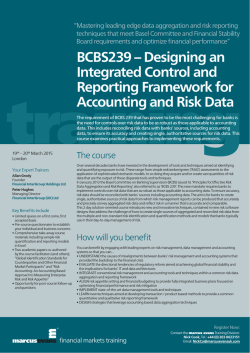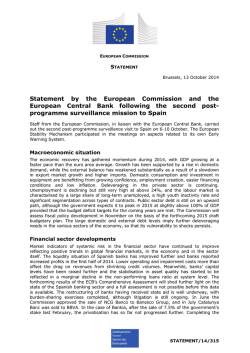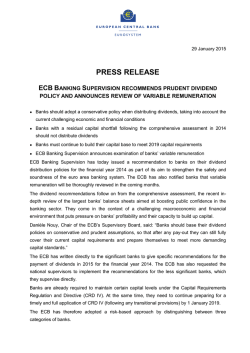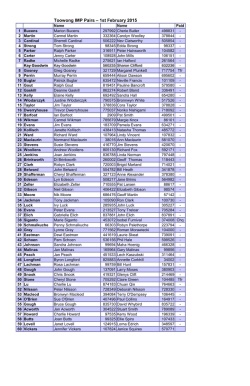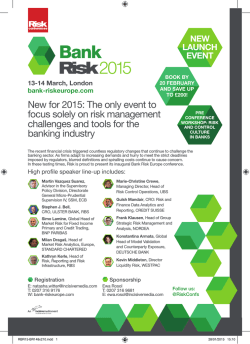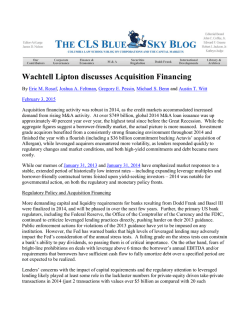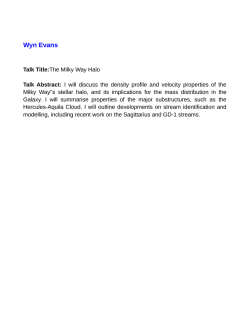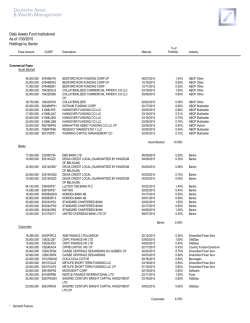
BCBS239- Designing an Integrated Control and Reporting
“ Mastering leading edge data aggregation and risk reporting techniques that meet Basel Committee and Financial Stability Board requirements and optimize financial performance “ BCBS239- Designing an Integrated Control and Reporting Framework for Accounting and Risk Data training The requirement of BCBS 239 that has proven to be the most challenging for banks is the need for controls over risk data to be as robust as those applicable to accounting data. This includes reconciling risk data with banks’ sources, including accounting data, to ensure its accuracy and creating single, authoritative sources for risk data. This course examines practical approaches to implementing these requirements. 2nd –3rd March 2015 New York City, USA The Course Over several decades banks have invested in the development of tools and techniques aimed at identifying and quantifying exposure to risk. These range from simple red/amber/green (‘RAG’) assessments to the application of sophisticated stochastic models. In so doing they acquire and/or create vast quantities of risk data that are the output of these disparate tools and techniques. Your Expert Trainer In January 2013 the Basel Committee on Banking Supervision (BCBS) issued its ‘Principles for Effective Risk Data Aggregation and Risk Reporting’ also referred to as ‘BCBS 239’. This new mandate requires banks to implement controls over risk data that are as robust as those applicable to accounting data. To ensure accuracy, risk data should be reconciled with banks’ sources including accounting data. The aim is for banks to create single, authoritative sources of risk data from which risk management reports can be produced that accurately and precisely convey aggregated risk data and reflect risk in a manner that is accurate and comparable. Peter Hughes Managing Director Financial InterGroup (UK) Ltd Allan Grody Founder Financial InterGroup Companies Key Benefits Include • Limited spaces on a first come, first accepted basis • Pre-course questionnaire to establish your individual and business concerns • Comprehensive take-away course materials including sample risk quantification and reporting models in Excel • Two academic papers co-authored by the course facilitators (and others); “Global Identification Standards for Counterparties and Other Financial Market Participants” and “Risk Accounting: An Accounting Based Approach to Measuring Enterprise Risk and Risk Appetite” • Opportunity for post-course follow-up and questions This 2 day solution-oriented course introduces new and innovative techniques, contained in new risk software designs that address the challenge of how to create single sources of aggregated and reconciled risk data from the multiple and non-standard risk identification and quantification methods and models that banks typically use in their day-to-day management of risk. How Will You Benefit? You can benefit by engaging with leading experts on risk management, data management and accounting systems so that you can • UNDERSTAND the causes of misalignments between banks’ risk management and accounting systems that provided the backdrop to the financial crisis • EVALUATE the directional tendencies of regulatory reform aimed at achieving global financial stability and the implications for banks’ IT and data architectures • INTEGRATE conventional risk management and accounting tools and techniques within a common risk data aggregation and reporting framework • ALIGN risk appetite setting and financial budgeting to provide fully integrated business plans focused on optimizing financial performance and risk mitigation • IMPLEMENT state-of-the-art data management tools and techniques • LEARN new techniques aimed at developing transaction / product based methods to provide a common quantitative and qualitative risk reporting framework • DESIGN strategies that leverage accounting based data aggregation techniques that optimise risk based capital management and enhance your bank’s ICAAP (internal capital adequacy assessment process) What People Are Saying About This Course “A good summary of the current state of risk reporting, some good ideas to consider” Suntrust “Fascinating, at times an eye-opener” Bank for International Settlements “Very useful materials balanced with current context and political environment” BBVA Compass Register Now: financial markets training Contact the marcus evans Training Division: Nick Cook, Tel.: +44 (0) 203 0023151 Email: [email protected] Meeting the Challenges of Risk Data Aggregation and Reporting Programme Day 1 Day 2 The Emerging Importance of Risk Data • The financial crisis: its causes and lessons learned • The shift in regulatory focus from risk models to risk data • Reporting frameworks: accounting data vs. risk data • Understanding risk data and its role in: – Risk appetite setting and monitoring – Risk pricing – Transaction and portfolio management – Enterprise risk management (ERM) – Capital adequacy and regulatory capital requirements – Systemic risk analysis • Banks’ data management challenges and status Adapting an Accounting Framework to Risk Data(Risk Accounting) • Defining the primary reportable components for risk reporting: –Organizational – Risk type – Products –Customers – Geography (location) • Organizational components and their categorization within a risk reporting framework: – Transaction processing – Risk management – Reference data maintenance – Business applications (IT) maintenance – Administration and support functions • The three pillars of organizational components and how their flawed interaction creates exposure to risk: – Manual processes – Automated processes –Data • Establishing the benchmark for optimal operating environments • Measuring deviations from the benchmark and the consequences for risk reporting • Creating a single source of risk data that is tied to the general ledger Case Study and Exercise One •The delegates identify their major issues and challenges for data management. Feedback is discussed and analyzed and common themes are identified Accounting Data- Control & Reporting Frameworks • The general ledger and sub-ledgers • The financial reporting cycle • Ensuring data accuracy: Proofs, reconciliations and substantiations • Financial accounting vs. management accounting • The values, codes and identifiers tagged onto transactions that drive aggregation • The importance of transaction control totals in financial reporting • Accounting standards and policies • The role of auditing • Overview of an example of legislation applied to financial reporting (Sarbanes Oxley – USA) BCBS 239 – An In-Depth Examination • The objectives of BCBS 239 • The Basel Committee’s risk data aggregation expectations for 2016 • The 14 principles and the challenges they represent • The status of implementation in banks Case Study and Exercise Two The delegates compare accounting control and reporting frameworks with BCBS 239. A gap analysis is performed and delegates conclude whether controls typically applied to accounting data and financial reporting can be applied to risk data and risk reporting. What are the challenges that must be overcome and the potential benefits. Aligning Accounting & Risk Data • The core requirements of effective risk data aggregation: – Common identification standards – Common unit of risk measurement • Dealing with multiple, non-standardised risk quantification and assessment methods • The treatment of internal risks vs. external risks • The limitations of monetary value as a unit of risk measurement • The concept of risk accounting as an extension of management accounting • Defining a common unit of risk measurement and reporting • The core risk metrics: maximum potential loss and probability of loss Designing and Implementing Standardized Risk Tables • The Value Table • Product Risk Tables • Operations Activity Risk Tables • Best Practice Scoring Templates Case Study and Exercise Four The delegates are presented with a Risk Accounting simulation of a complex financial product. The outputs of the simulation are risk metrics by risk type and a detailed product risk summary which are evaluated and critiqued. Regulatory Reform and the Importance of High Quality Risk Data • An overview of key papers recently issued by the BCBS and FSB aimed at regulatory reform that require high quality risk data and effective risk data aggregation: – BCBS-Balancing Risk Sensitivity, Simplicity & Comparability – BCBS-Measuring & Controlling Large Exposures – FSB-A Global Legal Entity Identifier (LEI) for Financial Markets – FSB-Principles for an Effective Risk Appetite Framework – FSB-Supervisory Interaction with Financial Institutions on Risk Culture A Risk Management Ecosystem • The design of a risk management ecosystem for banks • The key role of data management and risk accounting in the ecosystem • Further applications of risk accounting: – Risk based capital management and capital adequacy – Integrated risk and financial business planning – Risk adjusted performance measurement (RAPM) – Stress testing –Benchmarking Case Study and Exercise Three The delegates analyze a real-life business operating model and calculate core risk metrics that are used to produce enterprise-wide risk reporting. The outputs are subsequently evaluated and critiqued. Register Now: financial markets training Contact the marcus evans Training Division: Nick Cook, Tel.: +44 (0) 20 3002 3151 Email: [email protected] About Your Expert Trainers Allan Grody is one of the leading academics working at the forefront of the intersection of risk management and data management. He is the founder of Financial InterGroup Holdings Ltd, a strategic consulting and financial industry joint venture development company. He has been involved in the financial industry for his entire business career of nearly five decades. He has had hands on experience in multiple sectors of the financial industry and has been consulting domestically and internationally on issues related to financial institutions’ global strategies, capital and contract market restructuring, industry-wide financial business re-engineering, information systems, evolving communications infrastructures, and risk management methods and systems. In an earlier career he was the founder and partner-in-charge of Coopers & Lybrand’s (now PWC’s) Financial Services Consulting Practice. He founded and taught the only graduate level Risk Management Systems course at NYU’s Stern Graduate School of Business. He began his business career with General Electric Credit Corp. and later went on to hold positions in the investment management business with Neuberger Berman and in the securities industry with Morgan Stanley’s predecessor firm Dean Witter Reynolds. He later was an officer with ABN-AMRO’s predecessor bank (now Royal Bank of Scotland). He was a founding Member of the Board of Directors of the Technology Committee of the Futures Industry Association; an Executive Committee Member of the Emerging Business Council of the Information Industry Association; an Executive Board Member of the Vietnamese Capital Markets Committee; and, for nearly a decade, an Advisory Board Member to the London Stock Exchange’s annual Computers in the City Conference. He is currently a Founding Board Member of the Journal of Risk Management in Financial Institutions. Peter Hughes is a former banker with JPMorgan Chase, Fellow of the Institute of Chartered Accountants in England & Wales and a Visiting Research Fellow at the York Management School, University of York where he leads research into next generation risk management and accounting systems. Peter is a risk management, accounting and audit expert specializing in cross-enterprise risks, operational risk, data management, Basel II & III, capital management (including the Internal Capital Adequacy Assessment Process - ICAAP), risk measurement and management systems and risk based auditing. He was formerly a country / area executive with JPMorgan Chase. As a consultant and trainer, he has worked with a number of leading banks, rating agencies, global IT companies, consulting firms, trade associations and banking institutes in the UK, South Africa, Qatar, Egypt, Abu Dhabi, Kuwait, Mauritius, Romania, Italy, Croatia, Slovakia, Russia, Pakistan, USA, Jordan, Uganda, Tanzania, Rwanda, Ghana and the Philippines. In his 27 year career with JPMorgan Chase he was Regional Audit Manager (South America), Regional Head of Finance Shared Services (EMEA), Chief Auditor (Brazil), Country Operations Executive (Brazil), Country Senior Financial Officer (Brazil), Chief Operating Officer (Germany), Acting Head of Treasury & Trading (Germany) and Global Head of Risk Management – Shared Technology & Operations. about… Who Should Attend? This course offers an ideal forum in which to bring together executives, senior managers and key personnel from infrastructure functions at financial firms including: • • • • • • Finance Risk management Operations & IT Data management Audit Compliance The course will be of equal interest to regulators and consultants who advise financial firms. Teams from the same institution would find this of particular relevance. marcus evans financial markets training marcus evans financial markets training division has been developed to offer courses of the highest calibre to industry practitioners. Our clients’ increasing demands for high quality hands-on training, drives our focused output. Thorough research ensures their applicability to your current business concerns. Training courses are being offered on a world-wide basis from our production offices across Europe, the US, Australia and the Asia Pacific region. This international network affords a global view of emerging training needs in the most dynamic industries. marcus evans financial markets training is a division of marcus evans. Together we offer specialised courses and conferences in a broad range of industries including capital markets and wholesale finance, legal and business, general finance, energy, telecommunications and the media. Register Now: Contact the marcus evans Training Division Nick Cook, on: Tel.: +44 (0) 20 3 002 3151 Email: [email protected]
© Copyright 2026
